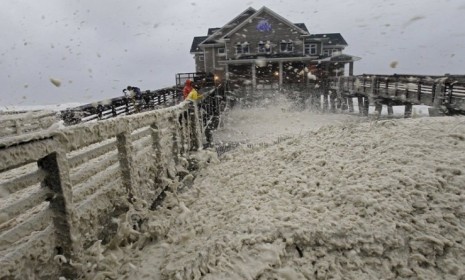Hurricane Sandy: 4 ways the huge 'Frankenstorm' is hammering America
The freakish, massive nor'easter is real, and unlike last year's Hurricane Irene, it could actually be the storm of the century

Hurricane Sandy is churning toward the most populous part of the U.S., and the National Weather Service wants the 60 million people in its path — mostly on the East Coast — to take the "extremely dangerous," potentially "historic storm" seriously. If you are reluctant to follow emergency instructions from local authorities, the NWS says, "think about your loved ones, think about the emergency responders who will be unable to reach you when you make the panicked phone call to be rescued, think about the rescue/recovery teams who will rescue you if you are injured or recover your remains if you do not survive." At least 65 deaths in the Caribbean have been blamed on Sandy, but even if no Americans die as a result of this "Frankenstorm," forecasters say it's shaping up to be the proverbial "big one." Here are four ways the massive storm is already roiling the U.S.:
1. Sandy has a third of the country in its sights
The Frankenstorm is a freak meeting of a northern hurricane, two converging cold fronts, and a full moon, creating a rare, destructive post-tropical cyclone, or nor'easter. Hurricane Sandy is forecast to make landfall in Delaware or southern New Jersey late Monday or early Tuesday, but its wide reach — hurricane-force winds spreading 175 miles out from the center, and tropical storm–force gales in a radius of 520 miles, likely sending strong winds to every state east of the Mississippi River — is already being felt from North Carolina to New York. "Although Sandy is a hurricane, it's important not to focus too much on its official category or its precise path," says The Associated Press. Between storm surges of up to 11 feet sloshing into New York Harbor and other parts of the Northeast and mid-Atlantic, a foot of rain and two feet of snow, and hurricane-force winds, there will be lots of messes to clean up after the storm has passed.
The Week
Escape your echo chamber. Get the facts behind the news, plus analysis from multiple perspectives.

Sign up for The Week's Free Newsletters
From our morning news briefing to a weekly Good News Newsletter, get the best of The Week delivered directly to your inbox.
From our morning news briefing to a weekly Good News Newsletter, get the best of The Week delivered directly to your inbox.
2. No trains, planes, or buses for at least a day
Thousands of travelers were stuck in cities from Washington to Boston, or prevented from flying there, as airlines canceled 8,000 flights through Tuesday, with more cancelations likely. Trains aren't an option, either, as Amtrak has suspended nearly all service along the Eastern seaboard. And locally, New York and New Jersey have stopped their commuter rails, cities from New York to Philadelphia to Washington have or will shut down their subways and bus systems. At least some mass transit will resume service in New York City about 12 hours after the storm passes, says MTA chairman Joseph Lhota, but commuters should expect two days of taxis or hoofing it. "I do think Monday and Tuesday are going to be difficult days."
3. Sandy will be expensive
Local businesses and national chain stores in parts of the Northeast will be closed on Monday, and the major U.S. stock and options markets will shut down for at least Monday and Tuesday — this is the first weather-related full suspension of trading at the New York Stock Exchange since 1985, and the first unscheduled closure since September 2001. Estimates about how much Sandy will cost range from $2 billion to $100 billion. Hurricane Irene, in 2011, caused about $15 billion in damage.
A free daily email with the biggest news stories of the day – and the best features from TheWeek.com
4. Election 2012, scrambled
The freakish superstorm is injecting chaos into the carefully planned final week of the presidential race, with both Obama and Romney shifting or canceling campaign appearances in affected swing states like Virginia and New Hampshire. Romney is beefing up his schedule in Ohio and Wisconsin while Obama canceled a Florida appearance on Monday to instead monitor the storm from Washington. Anything Sandy-stricken governors and mayors need, "we will be there," Obama said Sunday. "And we are going to cut through red tape. We are not going to get bogged down with a lot of rules." So Sandy isn't all bad, says Mike Lupica at the New York Daily News. "This will be one of those moments that transcends the general lousiness of this campaign, that involves the real life of this country that the candidates talk endlessly about, and not the latest tracking poll from Ohio or Florida." For one moment before the election, when "President Obama and not Candidate Obama" visits after the storm, at least one of the two men running for office will ignore the self-important swing states and treat New York like the crucial hub it is, like something more than an ATM.
Sources: AP (2), BuzzFeed, Forbes, New York Daily News, The New York Times, The Wall Street Journal (2), Weather Channel, Wunderground
More Hurricane Sandy coverage:
-Hurricane Sandy: Does it help President Obama politically?
-INTERACTIVE MAP: Follow Hurricane Sandy's progress in real time
-The last 'Frankenstorm': Video of the 1938 nor'easter that ravaged New England
-
 Heavenly spectacle in the wilds of Canada
Heavenly spectacle in the wilds of CanadaThe Week Recommends ‘Mind-bending’ outpost for spotting animals – and the northern lights
-
 Facial recognition: a revolution in policing
Facial recognition: a revolution in policingTalking Point All 43 police forces in England and Wales are set to be granted access, with those against calling for increasing safeguards on the technology
-
 Codeword: December 14, 2025
Codeword: December 14, 2025The daily codeword puzzle from The Week